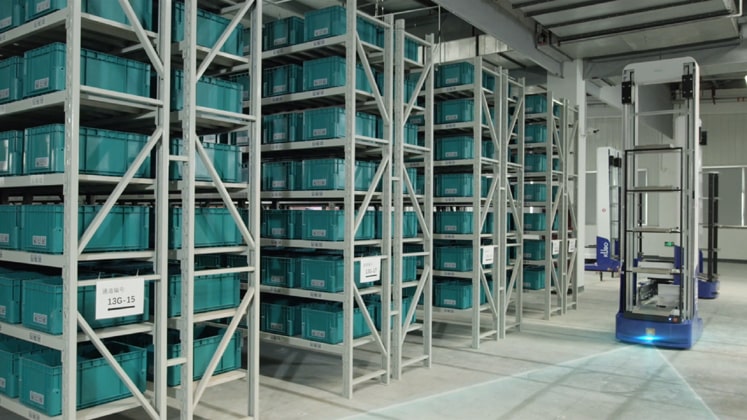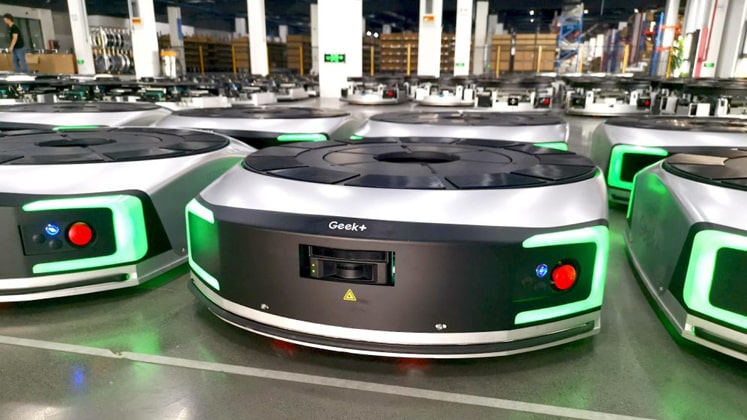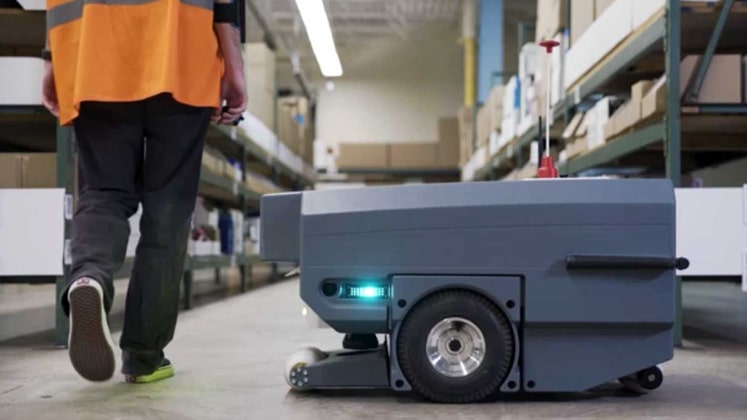One of the key challenges in the apparel industry is that apart from intense ongoing competition in this low-margin business, warehouse operators are having to deal with difficulties in finding human workforce who are willing to stay in the job for a longer run. Constantly advertising for new workers, hiring them and training them incur huge amount of money which further eats away the already tough margins in the apparel business.
Adding to this is the irony that the way apparel manufacturers handle materials in factory warehouses hasn’t seen a fundamental shift over the decades. Previously, it was manpower which used to transport materials from one place to another, and then gradual penetration of technology like Automated Guided Vehicles (AGVs) happened but a huge scope of advancement is still there. As other industries such as automotive, steel etc., are now challenging the status quo by using Autonomous Case-Handling Robots (ACR) or Autonomous Mobile Robots (AMRs) which perform various tasks all the way to automate material handling zone in a factory warehouse, the apparel industry also needs to show intent because it’s the need there for such robotics solutions, logistically.
Robotics offers a solution which would certainly transform the conventional warehouses. Gone are the days when the owners of an apparel factory had to think of automation as expensive installations, as now they can get their material handling job done using small autonomous mobile robots.
- Hai Robotics is one leading Chinese ACR/AMR Technology with significant installations in apparel sector…
Recently, Chinese tech giant Alibaba launched the new Rhino Smart Manufacturing Factory, which is said to be one-of-a-kind smart factory that incorporates a swathe of advanced technologies, including cloud computing, IoT, artificial intelligence, sewing automation and robotics. What’s interesting is that Alibaba is using all home-grown technologies in all areas within the factory premises. Hai Robotics, a pioneer in autonomous case-handling robots (ACR), has provided all robotics solutions to Alibaba for material handling.
Not just Alibaba, Hai Robotics has a number of installations in its name in the apparel industry. The company offers efficient, intelligent, flexible and customised warehouse and factory automation solutions through advanced robotics technology called HAIPICK System and AI algorithms.

HAIPICK robots include HAIPICK A42D – a double-deep shelving ACR that allows access to the second row of shelves, increasing storage density by up to 130 per cent; HAIPICK A42N – a carton-picking ACR that recognises cartons and totes without the need of codes, enabling mix picking of cartons and totes of different sizes; HAIPICK A42T – the telescopic lift ACR delivers ultra-wide storage space range (0.25m – 6.50m), suitable for warehouses with irregular heights and HAIPICK A42 SLAM – a Laser SLAM with mapping and laser capabilities that allow ultra-precision handling.
The maximum height of a HAIPICK robot is 6.50 metres that can be used to carry 8 cases in a factory warehouse. Even at a maximum speed of 1.80 metre/second, the robot has a picking control precision of ± 3 mm.
The HAIPICK robots remain all time connected with HAIQ software platform which performs data analysis and visual management to ensure the simultaneous dispatch of the multiple robots and various equipment for material handling.
Also Read: Automatic ‘Pick and Place’ technology in apparel and textile production can save direct costs!
Case Study of ERAL Apparel Factory in Lishui, Zhejiang (China) using Hai Robotics Technology
As the leading downjacket brand, ERAL uses customisation as an essential strategy to drive higher customer satisfaction and loyalty. However, customisation poses challenge for the company’s massive production setting. ERAL sought for solutions to transform its Zhejiang-based Apparel Factory into a smart plant to address the upcoming challenges. Hai Robotics installed its HAIPICK system in ERAL Apparel Factory back in November 2019. The solutions that were installed are: rack system; software system; sorting system and conveyor line.
Challenges that ERAL faced before…
- Increasing demand for small-batch production: As China is a growing apparel retail market and the consumers in the country are more inclined towards on-demand and personalised approach, ERAL found it difficult to manage these small-batch productions.
- Scattered receiving & picking tasks: Managing inventory was taking more time and the movement within factory was unorganised.
- Complex kitting process with thousands of items: It was an issue in the factory in the kitting process where related items are picked, packaged and supplied together as one part number for thousands of small orders.
- Low-density storage area designed for manual pick: To store a variety of raw materials in small quantities in a low density storage area and track them manually when needed for production was another challenge for the company.
Transformation after installing HAIPICK system…
As soon as ERAL opted for 8-case HAIPICK robot, it increased operation efficiency in material handling by 3 times and the storage density through HAI rack system increased by 80 per cent. HAIPICK now interacts with automatic conveyors in ERAL material handling area to provide smooth operation flow, automated picking and kitting process.
- Geek+ Robotics encounters numerous challenges with its picking robots

The fluctuation in number of orders and unpredictable sales pose big challenges for the picking efficiency and accuracy of the apparel companies. This happens as the diversified and personalised needs of consumer groups in today’s era are reshaping the apparel market and the relationship between supply and demand is driving enterprises to restructure their production mode, transforming from production-based marketing to on-demand production, and realising the transformation and upgrading of manufacturing. This new ‘consumer-centered consumption era’ is certainly pushing apparel industry to go for robotic solution particularly for material handling.
Geek+ Robotics, a supplier of warehouse robotics and automation systems, says its system can not only be installed within weeks, but also the time to see the return on investment is much shorter than in traditional warehouse automation systems.
The autonomous mobile robots of Geek+ cater to the challenges that occur due to highly mixed inventories and low-volume orders, which is a need of today’s mass customisation environment, where more shoppers want a greater variety of products than ever before.
According to the company, AI is integrated into its autonomous mobile robots and, at the moment, Geek+ robots feature the following AI functionalities:
- Mapping
- Navigation
- Collision avoidance
- Identification of SKUs
- Dynamic location
As it is already evident by having a look at today’s warehouses in the apparel industry that the first four points mentioned above are most common problems companies are facing; however the last one – dynamic location – is quite sophisticated. ‘Dynamic location’ is a term which means that the robot is connected to the cloud which stores data about which goods are selling fast and which ones slow.
Once this data is analysed, the robot will autonomously locate itself closer to the order-picking station if its shelf contains faster moving goods, and further away if its shelf contains slower selling goods. That is what AI can deliver in a warehouse.
Types of Geek+ robots and advantages…
At present, Geek+ offers 6 kinds of robots – P series, S series, C series, M series, F series and A series. For localisation and navigation, technologies like LiDAR (Light Detection and Ranging), visual SLAM (Simultaneous Localization and Mapping), 2D code systems and inertial navigation provide all these 6 types of robots with reliable positioning and navigation references through feature maps, without the need for intrusive infrastructure.
In order to achieve accurate detention of the target and understanding of the environment, the fusion of multi-sensor information such as RGBD camera, LiDAR and safety sensors is combined with deep learning algorithms. This also helps enhance the robot’s adaptability, robustness and operational safety to complex environments.
Another huge advantage of these robots is the motion control parameters with adaptive algorithm that’s based on the high-efficiency control model and realises the autonomous and efficient movements of different types of intelligent robots, soft and agile start-stop.
Case Study of Nike using Geek+ robots
- NIKE streamlines warehouse operations…
With fast increasing sales of shoes and clothes in Japan, Nike’s warehouse operators had to walk longer distances back and forth between the storage and packaging areas previously. What’s more challenging was the ageing population in the country that had increased scarcity and the cost of labour.
Solution…
In July 2019, Geek+ implemented 202 picking robots and 6,000 set racks in Nike’s new warehouse, which is spread in a 10,000 square metre area in Chiba prefecture in Japan that has now increased picking efficiency in the warehouse, mitigated labour shortages, streamlined warehouse operations to meet the rapid growth in online sales and bring same-day delivery to its customers.







